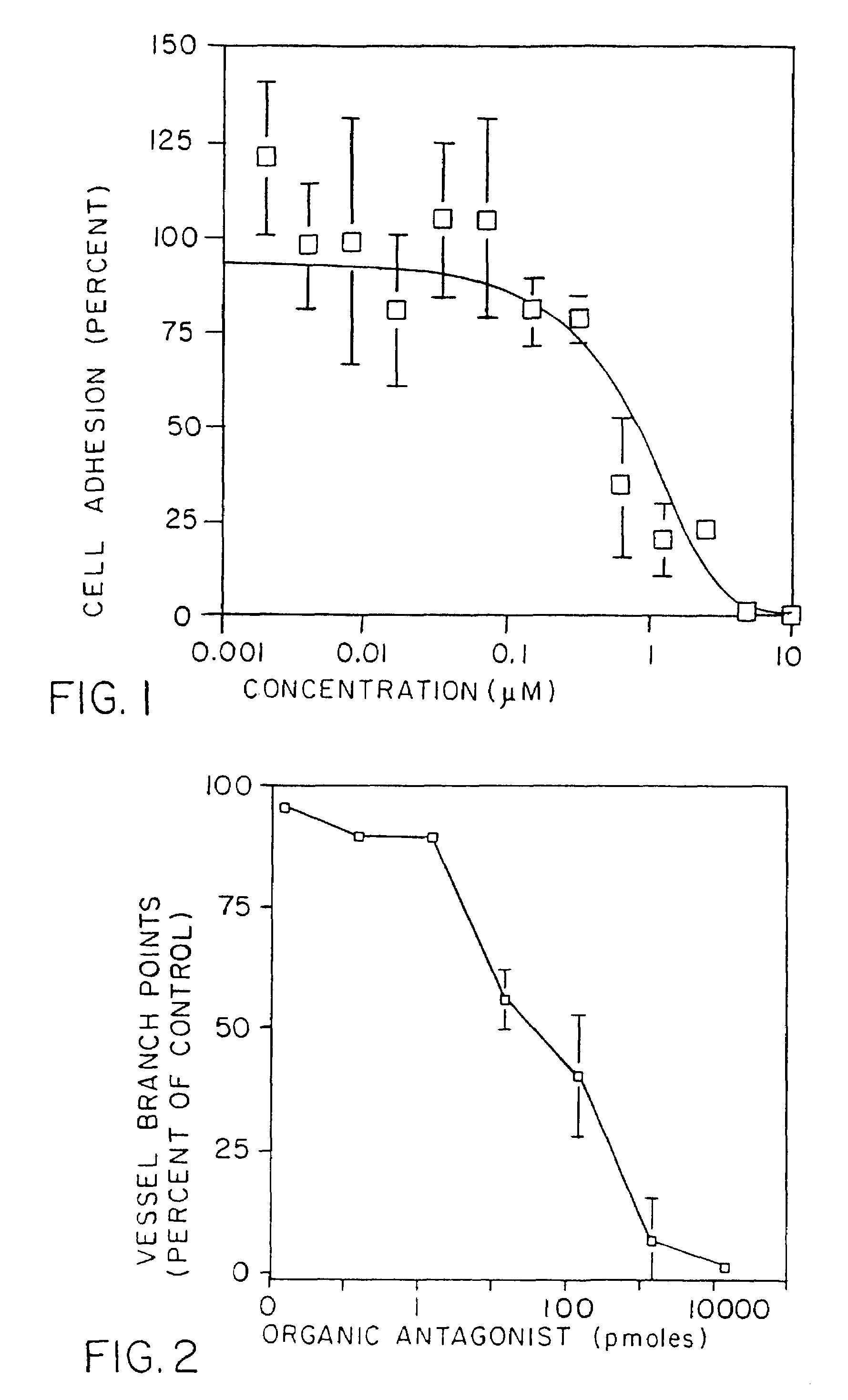Methods for detecting and inhibiting angiogenesis
a technology of angiogenesis and angiogenesis, which is applied in the field of methods for detecting and treating conditions, can solve the problems of coronary thrombosis, rupture and hemorrhage of blood-filled plaques, adversely affecting vision, etc., and achieves the effects of reducing or inhibiting angiogenesis, and reducing the severity of a pathological condition
- Summary
- Abstract
- Description
- Claims
- Application Information
AI Technical Summary
Benefits of technology
Problems solved by technology
Method used
Image
Examples
example i
α5β1 Integrin is Expressed During Angiogenesis
[0073]This Example provides immunohistochemical evidence that α5β1 is expressed in association with newly formed blood vessels in various human and mouse tumors.
[0074]Five μm frozen sections of human normal breast and colon, colon carcinoma, breast carcinoma, human tumor xenotransplants in six week old CB17 female SCID mice (Charles River; Wilmington Mass.), and in breast tumors from Mtag mice were fixed for 1 min in acetone, air dried and rehydrated for 5 min in phosphate buffered saline (PBS). Sections were blocked for 2 hr in 8% normal goat serum in PBS and incubated with: 1) 5 μg / ml anti-α5β1 cytoplasmic tail polyclonal antibody (AB1928P; Pharmingen, Inc.; San Diego Calif.) and 5 μg / ml murine anti-human CD31 monoclonal antibody (PECAM; MA-3100; Endogen); 2) 5 μg / ml anti-α5β1 monoclonal antibody and 5 μg / ml rabbit anti-von Willebrand's factor antibody (016P; Biogenex; San Ramon Calif.); or 3) 5 μg / ml anti-fibronectin cell binding pept...
example ii
α5β1 and Fibronectin are Required for Angiogenesis
[0079]This example demonstrates that fibronectin and the fibronectin receptor integrin α5β1 are involved in angiogenesis in tumors and in growth factor stimulated angiogenesis.
A. Methods
[0081]HT29 integrin α5β1+ cells, integrin α5β1− colon carcinoma cells (Varner et al., Mol. Biol. Cell 6:725–740 (1995)), and chick embryo fibroblasts (CEF's) were maintained in DMEM high glucose supplemented with 10% fetal bovine serum (FBS) and gentamycin. Human umbilical vein endothelial cells (HUVEC's) were maintained in M199 medium containing sodium bicarbonate, HEPES, heparin, endothelial cell growth supplement, 20% FBS and gentamycin. Culture media and reagents were from Irvine Scientific (Irvine, Calif.).
[0082]The wells of 48 well culture dishes (Costar, Inc.) were coated with 1 μg / ml vitronectin, 2 μg / ml fibronectin (chick embryo fibroblasts and HUVEC's) or 10 μg / ml fibronectin (HT29-α5+ cells) for 1 hr at 37° C., t...
example iii
α5β1 Antagonists Inhibit Growth Factor Induced Angiogenesis in Human Skin in SCID Mice
[0113]This example demonstrates that α5β1 antagonists inhibit angiogenesis in human skin grown in SCID mice.
[0114]Engraftment of SCID mice with human skins was performed as previously described (Brooks et al., J. Clin. Invest. 96:1815–1822 (1995)). SCID mice were engrafted with an 8 mm×13 mm piece of human neonatal foreskin. Fresh human neonatal foreskins were obtained from the Cooperative Human Tissue Network of the National Institutes of Health and were stored in RPMI-1640 medium supplemented with 2% fetal bovine serum and 1% gentamicin.
[0115]Four weeks after engraftment, after the skin had completely healed, 50 μl of growth factor depleted matrigel (Becton Dickenson; Bedford Mass.) reconstituted with 1 μg / ml basic fibroblast growth factor (bFGF), with 1 μg / ml bFGF containing 25 μg / ml anti-α5β1 function blocking monoclonal antibody or with 1 μg / ml bFGF containing 25 μg / ml non-function blocking an...
PUM
| Property | Measurement | Unit |
|---|---|---|
| volume | aaaaa | aaaaa |
| diameter | aaaaa | aaaaa |
| diameter | aaaaa | aaaaa |
Abstract
Description
Claims
Application Information
 Login to View More
Login to View More - R&D
- Intellectual Property
- Life Sciences
- Materials
- Tech Scout
- Unparalleled Data Quality
- Higher Quality Content
- 60% Fewer Hallucinations
Browse by: Latest US Patents, China's latest patents, Technical Efficacy Thesaurus, Application Domain, Technology Topic, Popular Technical Reports.
© 2025 PatSnap. All rights reserved.Legal|Privacy policy|Modern Slavery Act Transparency Statement|Sitemap|About US| Contact US: help@patsnap.com

